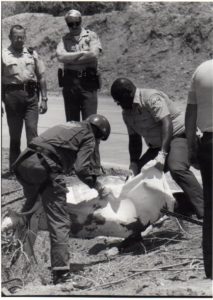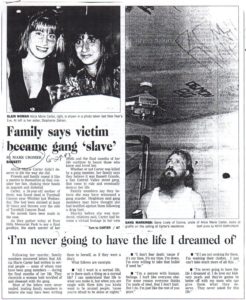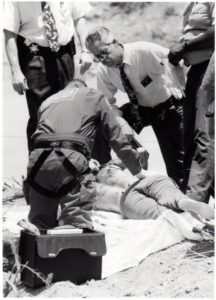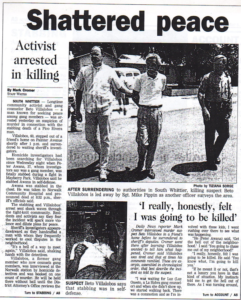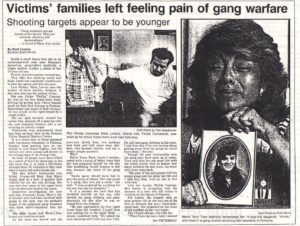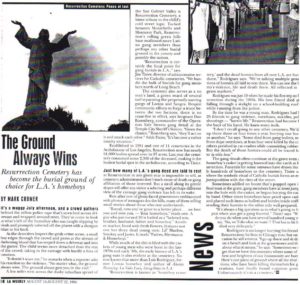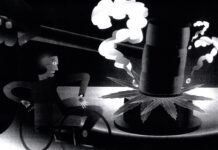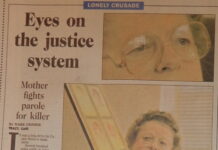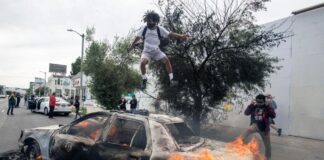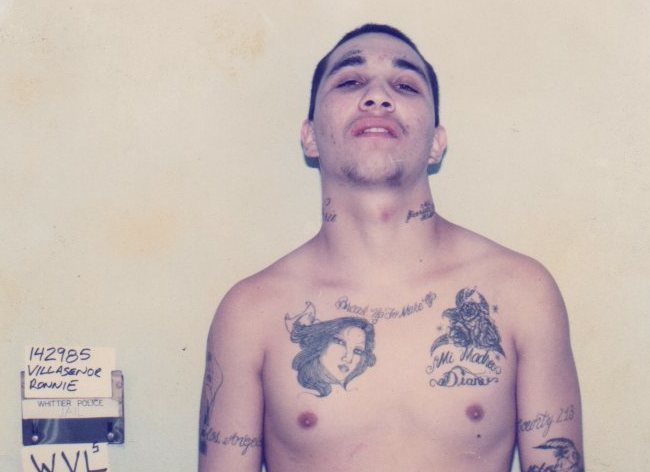
As a cold case finally closes on a young woman’s killing, a reflection on the grim business of writing about the darker nature of humankind
By Mark Cromer
It’s Election Day 2016 and as more than a hundred million Americans across the country make their way to the polls, I find myself in the District Attorney’s office at the Los Angeles County Superior Court in Norwalk, where I have been called as a witness in the capital murder case of People v. Morrad Modle Ghonim.
As I watch the prosecutor pour over evidence with forensic experts that includes post-mortem wound examinations as they discuss things like stippling, muzzle impressions and soot patterns, I am taken back through time on a trip down a grim memory lane.
Nearly a quarter century after 17-year-old Maria Victoria ‘Vicky’ Ghonim was shot to death in Creek Park, a 26-acre greenbelt that straddles a flood control channel in the comfortable bedroom community of La Mirada, the long arm of the law has reached across the Caribbean to find her former husband, Morrad Ghonim, snatch him from his life on the island of Antigua and haul him back to Southern California to put him on trial for his own life.
I am here because I had interviewed Morrad Ghonim shortly after his wife had been shot to death. I don’t really remember that much about talking with Morrad Ghonim way back when, other than remembering that I had indeed spoken with him about his wife’s murder.
As a young journalist then working the crime beat in Southeast Los Angeles County for a chain of daily newspapers, I apparently had been the only reporter to actually interview him shortly after his wife had been killed by a seemingly random gunman in the park. A then 19-year-old Morrad Ghonim had given me his version of the fatal shooting that had ended his wife’s life as he and the couple’s infant son sat in their car with her while she was shot to death.
In the early 1990s, death-by-random gunman in Los Angeles County was not exactly the moonshot in 1969. More like South Chicago today.
But it was a bloody blast from the past that began last summer when Sgt. Howard Cooper from the Los Angeles County Sheriff’s Department’s homicide bureau gave me a call and asked me if I remembered the murder of Vicky Ghonim in La Mirada, and surprisingly I did, at least in the broad brush strokes of an otherwise fairly garden variety killing that had faded over time and had become obscured by the sheer volume of mayhem I had once written about everyday as a newspaper reporter.
It was somewhat surprising because I’d covered far more horrifying killings than Vicky Ghonim’s—a sad testament of the human condition in itself I suppose—but I told Cooper that I recalled her murder along the basic generalities that she was a young mom gunned down in the park and she had her baby with her. And I remembered I’d interviewed her family members in the aftermath of the shooting, including her husband. Cooper explained that’s what he wanted to talk with me about. They had finally turned the cold case hot by making the shooter in her murder and the gunman in turn had rolled on the guy he claimed hired him to kill her: her husband.
I remember thinking it was probably all for a few hundred bucks and a six-pack and, as it turns out, I wasn’t that far off the mark. Some things never change—and the stunning cheapness some humans hold for the lives of others as well as their own is one of them.
I told Cooper that I was in Seattle and at any rate I didn’t think I could offer more than what I’d recalled over the phone, but I said that I would look through my archives when I was back in LA and let him know if I still had my notes from that story and we could talk more then if I did. In the meantime, Cooper emailed me the clips of my old stories on the murder that the original detectives working the case had kept in their homicide file.
As I looked back over them for the first time nearly 25 years after I had written them, I was struck by the stories ability to transport me in a flash back to that time and place as well as the eerie quality of the sameness that crime reportage eventually carries for reporters working the beat.
Predator. Victim. Death.
The headline of my first story, ‘Park-goers in shock in aftermath of murder,’ was followed by my lead of: “To Joan Garcia, it sounded like firecrackers. A distant ‘pop, pop, pop,’ noise coming from the park.” Such was the inauspicious end of Vicky Ghonim’s life, heralded by fireworks-like popping and then moans. The story goes on to deliver the then still sparse details of her murder and residents concerns that crime was creeping into the park, with one describing the ‘Hessians and Cholos’ that kept her out of the park by dark.
My second story was headlined ‘Picking up the pieces: Family numb as violence claims young mother’ and opened with: “It was the spot where their life together began several years ago, the place where they met on their first date after sneaking away from school. On Thursday night, in a hail of bullets and screams, it was where it all came to an end.”
It was my reporting of this second story and my conversation with Morrad Ghonim in particular that Cooper was interested in, what I might recall either by memory or—Eureka!—the Mother Lode that might be found in my notes or cassette tapes if I still had my old story file.
A journalist searching his archives in order to possibly assist a law enforcement agency that was building a capital murder case against a suspect may seem counter-intuitive or possibly even professionally ethically questionable to some, but only to the uninitiated or perhaps those still locked in the oxygen-rich confines that the hyperbaric chambers their journalism classrooms provide. When I became a professional reporter thirty years ago, emerging from the university as part of the last generation of pre-Internet journalists into that twilight era of print journalism, my peers and I had spent years studying the academics of our tradecraft before we had much of that education very quickly scrubbed away with the beautiful, bustling reality of the newsrooms and the cold, hardball realities of working a cutthroat beat in the days of competitive newspapers.
Just like cops, there’s the academy—and then there’s the reality of the station and the streets.
And one of those stark realities was that reporters sometimes shared information in order to obtain information. There are a lot of caveats and variables in play with that equation, a lot of moving parts, but it is just a stone cold fact of journalistic life as a reporter develops reliable sources on their beat. I worked the phones everyday as we all did, but I also liked to burn a lot of shoe leather working my beat and over time it paid off. I had cops [from radio car-driving, shift-humping ‘runners and gunners’ to the brass in air-conditioned offices] giving me everything from tips in advance of busts to clandestinely passing me copies of police reports on active investigations. In turn, and only on appropriate occasions, I might have been asked to provide them with some additional insight or perspective on one matter or another. And that dynamic was in play sometimes on the other side of the street as well, with certain proverbial ‘bad guys’ willing to offer up a potentially valuable lead here or there and in return, down the road, might ask me what I’d heard about this, that or the other. Prosecutors and defense attorneys too, it was just the nature of the game.
And it was fun and games.
So searching my files for notes from an old murder I had covered in the early 1990s in the event it might help homicide detectives in pursuit of justice for the victim—and perhaps that does date me, as I truly believe that’s what cops do, day in and day out—wasn’t really so much of an issue for me.
But there were a few considerations I applied, the first being that despite the distant memory that Vicky Ghonim’s murder was for me one thing I was certain of was that all of the interviews I conducted in reporting the story were on-the-record interviews for publication and the people I spoke with understood that. I also knew that I wasn’t covering the story any longer and didn’t intend to start covering it again during Morrad Ghonim’s trial. And if I still had my notes from the story, I hadn’t committed to anything more than looking them over—not turning them over.
Back in LA I did indeed carefully pour over my archives from that era and, while I thought there was some chance I might actually have my old story file from Vicky Ghonim’s murder, it was not there.
When I told Cooper I didn’t have the file, he asked if we could meet anyway and discuss what I did recall about the story and my interview with Morrad Ghonim. I agreed and suggested a favored bar of mine and a week or so later we were sitting across a table from each other where, after shooting the shit about law and order in Los Angeles County and old players we both knew, we got down to business—and it was after all a business call—and I told him pretty much what I had told him over the phone from Seattle: I remembered covering Vicky Ghonim’s murder, I remembered broad generalities like they were a young couple in a park, they had their baby with them, she was shot. She died.
And I remembered going over to a family member’s home shortly after the murder during what was essentially a wake with grieving family members present that I interviewed to gain a better understanding of the woman who was killed and of the family her murder had left shattered. During that wake, I told Cooper, one vivid if useless recollection I had was the men in the family were chain smoking and drinking what I remember as Turkish coffee, and cigarettes and coffee were offered to me. While I wasn’t yet really a smoker, I found myself politely accepting and then puffing away on Marlboro reds and drinking coffee that seemed to have the viscosity of Pennzoil as my eyes watered and I tried hard to suppress a fit of hacking.
Not exactly a helpful memory to Cooper or the DA’s case, but it was one of the more clear recollections I had about reporting that story. If Cooper had been hoping I might have had a ‘recovered memory’ along the lines that I had found Morrad Ghonim rather blasé during our interview about his wife’s murder, perhaps suddenly recalling that her husband had told me that he was bummed about his wife’s murder but would feel better after the funeral as he planned to jet off to the Caribbean for some R&R on a sandy beach under azure skies and ease his grief in a hammock nursing a coconut filled with Puerto Rican rum, he would have been disappointed.
I just didn’t remember that happening. And believe me, I would have.
Hell, I would have remembered if Morrad Ghonim had started profusely sweating and was unable to make eye contact during the interview, or if his story had made no sense whatsoever. And that would have been spelled out in my reporting at the time. But even had Morrad Ghonim acted notably more oddly than most people who’ve just had a sudden horror visited upon them, I’m not sure I would have taken it as anything close to evidence of guilt. One of the many things reporters learn on the crime beat is that people manifest their emotions in a myriad of different ways as they process a terrifying event in their life—from a house burning down to a child’s drowning to a murder—and it usually has little to do with anything more than the frailty and nuances of their own humanity. They may hit the bottle, punch a wall, spend money recklessly, refuse to get out of bed, pop pills, sleep with an old lover or find comfort in a new one; or they may stay neatly between the lines that various cultures have drawn as some surreal Guide for Proper Grieving.
But either way it really doesn’t mean shit, at least in and of itself.
And from the little I recalled from the Ghonim household in the wake of Vicky Ghonim’s murder, nothing about Morrad Ghonim’s grieving seemed out of the ordinary.
But while a veteran like Cooper may have been hoping for an unexpected gift from the recesses of the medial temporal lobe of my brain, in the alternative he knew that there was something else to be had by sitting down with me to discuss what I recalled about the case.
The crux of his line of inquiry was more mundane but equally important: I had interviewed Morrad Ghonim within days of his wife’s murder and he had willingly given me, on the record, a fairly detailed account of the events of his wife’s murder. I wasn’t a cop, he wasn’t under interrogation and it was fresh. So in lieu of some explosive revelation that emerged from the mists of my memory, Cooper dialed in on what good cops become experts at distilling: seemingly mundane facts that become critical.
If I understandably didn’t have a clear or compelling memory of the specific details of what Morrad Ghonim told me nearly a quarter century ago, perhaps I remembered what my best practices and protocols were while conducting interviews as I reported such stories? Did I take notes? Did I record the interviews?
I usually did both. I’d record interviews, with the recorder in plain sight of the interviewee while also asking the subject if they understood they were being recorded and their comments were on-the-record, then during the interview I would take skeleton notes; notations that catch the bones of what the source is saying in order to cue up the tape of the interview later and quickly fill in the meat of the critical quotes verbatim. In certain cases my notes might be verbatim quotes or comments on key points.
And I told Cooper that there was one thing I would have clearly remembered had it happened: once my stories on Vicky Ghonim’s murder were published there had been no calls for clarifications, corrections or, God forbid, an outright retraction by any party to the story, including Morrad Ghonim. As a journalist, a clarification or correction to my work was an exceedingly rare event and a retraction would fall into the category of never ever. So I would have recalled quite vividly if Morrad Ghonim or any of the other family members had called me, or my editors, after the stories had landed on breakfast tables across the Southland, to say ‘Hey, you botched my account of Vicky’s killing. You got what I told you wrong. That’s not what I said.’
Because that is what he said, and that proved to be important as he stood trial for his life.
As we concluded our conversation that afternoon late last summer, Cooper offered almost in passing “You’d make a good witness.”
I told him I’d be happy to repeat what I had told him, but didn’t imagine saying that I had no specific recollection of the details of what Morrad Ghonim had told me about his wife’s murder all those years ago beyond what had already been published would be of much use to his case. He told me they wouldn’t need me as a witness at trial. Not to worry about it.
We made our farewells.
And a little over a year later I was looking at a subpoena.
I was probably more surprised that the case was actually still ongoing than anything else, figuring that a cold case turned a capital one would likely result in a plea deal, but I was also a little perturbed that Cooper’s estimation that I wouldn’t be called to the stand had evaporated into a formal ‘Save The Date’ notice from the District Attorney. My predisposition to repeat under oath the little that I could recall about Vicky Ghonim’s murder in 2015 had ebbed rather rapidly as I perused the subpoena in late 2016.
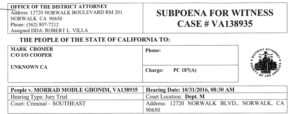
I suspected that by sitting down and discussing the case with Cooper I had compromised the protections that I would normally be afforded under California’s ‘shield law’—the legal strictures that generally prevent reporters from being dragged into court and compelled to reveal information they may possess, particularly if it has not been published. But since I didn’t have my story file and considering that I had conducted the interviews in question almost 25 years ago, I had to wonder what they were actually fishing for by trying to put me on the stand?
So I reached out to Peter Scheer, the Executive Director of the California First Amendment Coalition, for some perspective and potential guidance on the matter. More than two decades earlier the coalition, then helmed by legendary Brown Act ombudsman Terry Francke, had lined up Gibson, Dunn & Crutcher for me during a First Amendment showdown I had with some colleges in Southern California. That was the legal equivalent of calling 911 to report some menacing thugs (albeit it in suits) and instead of dispatching the police they send in the 82nd Airborne. It was quite heartening, to say the least, and problem solved.
Scheer agreed the prosecutor was likely to argue that I had waived my shield law protection by agreeing to discuss the case with Cooper, whether on background or not, but he felt a compelling argument could still be made under the provisions of the law that could convince a judge to quash the subpoena if I didn’t want to testify. Over the following week I discussed the issue with several attorneys who agreed there were several viable ways to keep me off the stand and then Jean-Paul Jassy, a Los Angeles-based litigator that specializes in media law, spoke with Deputy District Attorney Robert Villa on my behalf and the prosecutor, while disinclined to withdraw the subpoena, assured him the line of questioning would remain strictly within the universe of published material.
Jassy was prepared to file and argue a motion to quash the subpoena and immediately appeal the ruling if the trial judge didn’t agree, as well as appear in court with me to defend my interests in the event that I was compelled to take the stand. I also knew that if I didn’t appear in court as ordered while there was a good chance I would be found in contempt, my attorney would request that the judge immediately stay the bench warrant for my arrest pending appeal, which is traditionally granted in such instances with media-related subpoenas, and we could go from there.
Of course the wild card in any such case is what the defense counsel would do once I was on the stand, as judges overseeing capital murder trials tend to grant broad latitude to the defendant’s lawyers and their line of questioning rather than risk some reversible error down the legal road.
Still, I could only remember what I remembered and what I wrote had been published and was a matter of public record and it was factually accurate.
So I decided if the prosecutor wanted to call me to the witness stand, I would testify.
[]
As I sit inside one of Deputy DA Villa’s offices in the Norwalk Courthouse, I gaze over the mountain of casework that’s stacked across the table and listen to the prosecutor and detective prep some of the witnesses. I think one is a firearms expert and the other is perhaps a medical examiner. Villa and Cooper are explaining the sequence of the actual shooting and what the gunman told them he had done. The gunman was shooting her in the head “but she wouldn’t die,” one of them said, noting that Vicky Ghonim had been reflexively waving her hands around her face and head as she was being shot, as if to block the bullets. So he shot her in her thigh and when she dropped her hands to that wound “he stuck the gun in her eye and pulled the trigger.”
And nobody in this room is horrified by that.
As I listen to them talk, memories of the parade of carnage I spent years reporting and writing about on the crime beat begin to resurface.
Like a Kodak slideshow, one frame after another. Quickly.
It’s a vivid jumble of mayhem.
I remember the guy driving on East End Avenue into Pomona’s southside one afternoon who caught a bullet in his right temple that blew half his head onto the dashboard and windshield, sending his car drifting into oncoming traffic and causing a head-on collision. As fate would have it, his mother had been driving home from work when she rolled up to the scene of the ‘car accident’ and recognized her son’s car. She was told her son had been transported to the hospital and she raced there, where she was informed by emergency room doctors that her son was dead, as the gunshot wound had been too grievous (think Kennedy in Dallas). She told me later that she had been relieved to hear this and she told the doctors they had the wrong parent. She told them that her son had not been shot, rather he’d been in a car accident. She needed to know how he was doing. Then the doctors gently explained to her what the cops on the scene had not: that her son had indeed been shot, after which he was in a terrible car wreck that he never felt. I remember me and the photographer I was working with that day, a photog known as ‘Zaz’ among reporters at the paper we worked for at the time, making our way to the scene quickly and looking over the vehicle and we could see what was still inside of it and consequently realized that the driver was DOA at Pomona Valley Hospital Medical Center. And I remember showing my girlfriend at the time the black and white photograph that ran with my story and pointing out the gray schmear visible along the car’s lower windshield. “See that, baby? That’s his brains.”
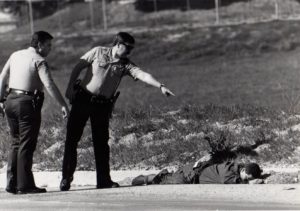
I remember the story down in Chino, that I also covered with Zaz, that had gone from a missing woman report to suspected foul play to the phone call I got from a copper alerting me “We’ve got a body.” When we got down there the house was taped off and crawling with dicks (trigger warning to Millennials: ‘dicks’ is an old school, non-derogatory reference to detectives) and Zaz and I went to one of the victim’s neighbors house and they let us into their backyard and I remember Zaz and I peering over their back fence into the missing woman’s backyard to see various spots which had been dug up. But we couldn’t see a body and were fairly sure they hadn’t extracted her yet since we’d got down there fast. So where was she? And I remember that we then both looked down along the fence line to see an excavation that revealed what appeared to be trash bags and what looked to be a decomposing knee. In a testament to how long ago that was and the different dynamic that was in play between cops and reporters back then (this would have been circa 1990), after her body was removed the detectives actually took us through the house and explained how they felt her murder had unfolded, pointing out where her boyfriend’s assault started, where she ran and where he appeared to have finished her off. I think that was the first time I really became aware of Luminol, as they were able to track the attack by the blood splatter, which he had cleaned up before splitting. Smart killer that he was, however, I seem to recall that he had kept using her credit cards while on the run. I think they got him in New Mexico or Texas.
Cops walking a reporter and a photographer through a crime scene for a post-mortem play-by-play, well, those were the days.
Actually, that symbiotic relationship once went far deeper than coppers walking friendly reporters through a murder scene. One of the veteran news photographers I worked with regularly back then and would work with for many years to come, was famed around the newsroom for having been at the scene of a dead junkie found at—yes, wait for it—a local cemetery. The hype apparently had wanted some peace and quiet as he fixed and turns out he picked the right spot to OD, as he kicked while still tied off and leaning against a gravestone. Nice touch, really, when you think about it. The cops not only allowed our photographer to snap a few frames of the stiff, but then they posed with the smack attack victim, a la the men of Col. Hugo Martinez’s ‘Search Bloc’ that wasted Pablo Escobar in 1993, as my colleague and friend took a few memorial photos for their own scrapbooks. In an era long before digital photography and the Internet arrived, this meant the cops posed with a dead junkie in the cemetery and allowed the photographer to develop the shots back in the darkroom and deliver prints to the officers later, which he did. That’s what a real working relationship looked like back then. That’s what real working trust looked like.
It looked like that and more for me on the crime beat. I watched cops I was riding with choke dudes out on the hood of their patrol cars and never said a thing. And I watched gangsters I was hanging with throw dope and weapons as the ‘placas’ rolled up and I didn’t say shit about that either.
Both sides of the street.
And I remember guys getting taken for a ride by their homies only to get clipped and dumped on the side of the road. I remember wondering if they had that last second ‘Oh, no!’ moment immortalized by Joe Pesci in the film Good Fellas before their screen went blank. That last fleeting thought of ‘Shit, I should not have got in the car.’
And I remember various bodies getting pulled out of the canyons.
Canyons seemed a favored dumping ground for killers. I recall the story I wrote about a bicyclist peddling down a canyon road just to pass a stopped car and two people rolling a drum over the side; which turned out to be a wife and her boyfriend at her husband’s going away party. The cyclist didn’t stop to ask what they were doing, but sensing something may be a tad askew, he peddled as fast as he could down the canyon and I think made it to a fire station where he reported what he saw. They eventually found and hauled the container up (and I think it was a blue barrel) and, based on the cyclist’s information, were able to pop the wife and her new beau. Ain’t that a bitch.
I remember the body of the chick who had made the mistake of hanging out with Big Bassett, a street gang not far from where my mom taught elementary school in La Puente, getting hauled out of Turnbull Canyon, and the cops telling me she had been stabbed with something like a screwdriver with such force that it had resulted in ‘through and through’ wounds. I remember the speculation was that she was likely killed simply because she had seen or knew something that was a potential liability for the gang. So she had to go.
Ah, yes, the canyons. I remember driving up to Tracy, California, with another great news photographer, to cover the parole hearing for convicted killer David Kuns, who one night back in 1978 had chosen 14-year-old Benjamin Davis for a thrill-kill as the teen walked home from the first party his mother had let him attend. I remember LASD letting me into their homicide files at the old Hall of Justice in downtown LA and reading the reports and looking at the photos of what Kuns had done to Davis after plucking him off the street, throwing him into the back of a car driven by a friend, and unleashing a frenzied attack with a knife, just for the ‘fun’ of it. I remember they drove him up the canyon and threw him off the side, but then, still hearing him moaning down below, Kuns made his way down the canyon in the dark and continued to attack Davis, smashing him with rocks. Believing that he was finally dead, Kuns and his accomplice left. But Davis wasn’t dead, and he eventually managed to crawl up the side of the canyon back to the road, where a passing motorist stopped, put him in the back of his pickup truck and drove him to Queen of The Valley Hospital in West Covina where he lingered for a day or two before dying. And I remember meeting Kuns years later in that Central California prison, the day before his parole hearing, and how empty he seemed. Like a husk. I remember asking him if he thought he would be granted parole and he replied “No.” When I asked him why, he said simply “Because you’re here.” At his parole hearing the next day, after the case had been made for his release, Benjamin Davis’s mother Colleen stood up and showed the parole board members pictures of what her Benjamin had looked like the night she let him leave, against her better judgment, to that party. Then she held up photos of what her son looked like after Kuns was done with him. And she asked the parole board that Kuns not be released. And in that moment I knew Kuns was right, as the parole board members witnessed in that small room a stoic mother pleading with them not to allow the man that had butchered her son to walk the streets free again just yet—and they also saw a reporter taking notes of her emotional testimony and a news photographer taking pictures of it. Parole denied.
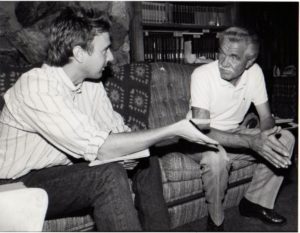
And I remember Beto Villalobos, the old veterano turned community activist in South Whittier, a deceivingly unassuming cat that was Hollywood handsome with a small tattoo of ‘Primera Flats’ that harkened back to his days of White Fence in LA and that I’d come to know over the years on the beat, one who’d plugged me into various shot-callers of Southside Whittier at their headquarters in Mayberry Park, and I remember the day I’d gotten a call from another old school dude in the barrio who informed me that Beto had just killed a vato and wanted to talk with me before turning himself in. Shortly thereafter I found myself in a pad in Sunshine Acres with a photographer (who I remember had gone to school with the Menendez brothers) and talking, but mostly just listening, about murder. I remember he told me about the knife going into the guy, and then how he rode the buses all night around LA to avoid the cops. I remember the phone started ringing and our host picked it up. I remember he said something along the lines of “Yeah, yeah, he’s here. Ok. Ok. Yeah. I understand. Uh, but I should tell you, there’s a reporter and a photographer with him here too, from the newspaper. Yeah. That’s right. No, it’s just the four of us, that’s it. Ok, I’ll tell them. Yep, right now.” Turns out while I’d got there first, the cops weren’t terribly far behind and now had the house surrounded. Our host advised they wanted the photographer and I to come out of the house first, with our hands up. We shook hands with Beto and made our farewells. And I remember Jesse Katz, then still at the LA Times, called me later and congratulated me on the scoop. Beto died in prison.
And I remember Ronnie Villasenor, a stone predator with Whittier Varrio Locos, who some of my cop sources said was good for multiple homicides, getting smoked as he walked down the street one day. I seem to recall Ronnie got popped from a shooter in a car, went down, then got back up and started to run as the car followed alongside. Ronnie got popped again. Ronnie went down again. Then Ronnie got back up again and started to run before getting blasted for the final time. I remember this because I remember we were laughing in the newsroom as we called him the ‘Michael Meyers’ of Whittier Varrio Locos. You dump him, but he gets back up. Dump him again, and look out! He’s back on his feet. I remember we shook our heads as we mused ‘If he had just stayed down the first time, he might still be around today to victimize innocent people.’ But I remember I wasn’t laughing the next day after the story hit and his mother called me. She was distraught, understandably, and insistent that while I hadn’t got the facts of the story wrong, the context was completely out of place. “Ronnie was not a homeboy!” she kept telling me. “He was not a homeboy. He was a kickback. Ronnie was a hangout.” I remember thinking two things at the time: one was the depth of her denial about her son’s actual reality, his actual identity, as she vehemently protested my story as if he was simply a member of Whittier Troop 13 in the Boy Scouts of America, packing nothing more than dangerous than a flashlight. The second was her incongruous familiarity with actual gang slang, using terms like ‘hangout’ and ‘kickback’ to describe her son’s connection with one of the local packs of killers. I guess she knew enough about the murderous truth of her son to not want to believe it. And yet it was still hard to not feel bad for her, even if her Ronnie’s death probably resulted in lives being saved down the road. Innocent civilian lives. I remember thinking ‘Oh madre, bad news sweetheart. See, if you had just noticed the ‘WVL’ tattooed above your Ronnie’s eyebrows, you’d have glimpsed the cold truth of what your little Boy Scout was up to on the street.’ But no. All you have is no entiendo, and I’m afraid it’s too late for that.
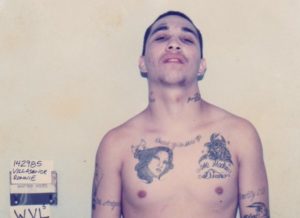
Ah, memories. Bloody, bloody memories. Fast frames clicking through my mind, flashing across the screen in just part of a highlight reel of the totality of what I’ve seen. What I’ve learned. What I know.
[]
And now here I am, back in the courthouse.
Cooper and Villa are talking to another witness in the office, a guy who Morrad Ghonim had called just a week or so before his wife’s murder and told him that she had come home with a hickey on her neck that he wasn’t sure whether or not he’d given it to her. Morrad Ghonim was in panic mode, the witness explained, asking if they could get together and talk. He had to figure shit out about his bitch. A couple of days later, Morrad Ghonim called the witness back in an entirely different mood. All was good. It was cool. Like the previous conversation had never happened. The witness told Cooper and Villa that Morrad and Vicky were supposed to have dinner with him and his lady the following week, but it never happened, as Vicky Ghonim was killed a few days after that last phone call.
Finally it’s time to head into the courtroom and as we make our way upstairs I find myself talking with the smart-looking, attractive blonde who I think was their firearms expert. She seems engaged and interested as we banter about the case and what I think about it. But the more we talk the more I realize she seems to think I’m a cop. So I tell her I am actually one of the journalists that had covered the story of Vicky Ghonim’s murder and then, like magic—Boom!—I watch her just disappear, peeling away to go sit on a bench across the hallway. I feel tempted to shout at her “Nothing we just said was on the record! Any chance I can still get your number?” But I don’t. Oh well.
I’m the first witness called following the afternoon break.
It has been a long time since I’ve been called to the witness stand and as I shuffle through the courtroom I become more acutely aware of my decision not to put on a suit for the occasion. Blue jeans, loafers and a St. Johns Bay buttoned shirt left mercifully un-tucked, I show up as me. Yep!
I swore to tell the truth, the whole truth and nothing but the truth, so help me God.
And I did.
It didn’t last that long.
True to his word to the media attorney Jassy, the prosecutor Villa asked only a series of short questions that were clearly designed to demonstrate for the jury that I had interviewed Morrad Ghonim shortly after the murder of his wife and that he in fact had told me what was published in the chain of newspapers I was writing for back then.
I was instructed to read a passage from one of my stories:
They had dinner in Cerritos and then, at Vicky’s suggestion, they drove to Creek Park in La Mirada to show the baby the horses that are stabled there.
“We were going to look at some cars later on, but we wanted to go to the park first before it got too late,” Ghonim said.
They were only in the park for several minutes before a crowd of what may have been Latino gang bangers began shouting obscenities at Vicky. Afraid, they returned to the car quickly, Ghonim said.
But before he could get out of the parking lot, gunfire erupted.
“I heard [her] screaming…and she hugged me, covered me,” he said. “She just held me and looked at me, then she didn’t do anything. I was just screaming and trying to drive.”
It was the last part of the section of my story that made sense to me on the stand, as in the DA’s office only hours before I had heard Villa asking one of the forensic experts whether Vicky Ghonim, after taking that last shot to her head, would have been able to turn to her husband Morrad Ghonim sitting in the driver’s seat and done anything, i.e. ‘hugged’ or ‘covered’ him. And the expert had said with that last bullet slamming into her brain she may have reflexively spun toward the driver’s seat by force of impact, but intentionally doing anything like hugging or covering somebody next to her was not possible.
Morrad Ghonim’s story to me wasn’t just that it didn’t jibe with what he had apparently told other people at the time, but that he had committed to record a version of events that wasn’t physically possible.
And that’s why I was there.
Defense counsel indeed made a go of it, pursuing an affirmative defense with a line of questioning that sought to cast doubt not so much as to the veracity of my interview with Morrad Ghonim, but cloud it with who else I had spoken with at the time, who else may have told me things that were in my stories but not as direct quotes.
Do I remember being at the park? Have I been there since? I talked to a lot of people about this murder, yes? How many? Do I still have my notes? Is it safe to say a lot of people told me a lot of things about this murder? And I can’t really say just exactly who told me exactly what and when, right? And…and…and…
Muddy the water. Cast doubt. Sow confusion.
Actually, I didn’t mind.
I learned a long, long time ago that people tend to view attorneys as something akin to used cars salesmen, only somewhere south of them, until they need one of course, and then suddenly that ‘greasy snake-handler’ of a lawyer becomes their baby’s Godparent invited to share Christmas dinner at home.
So I didn’t take offense at the line of inquiry. I understood and quite frankly, if it were my life on the line, I’d have wanted the same and more. I’d have wanted my lawyer to ask the witness what my mother’s sixth-grade boyfriend’s father’s middle name was and then shout “Ah-Ha!” when the witness drew a blank.
Still, we were going in circles—a good lawyer can ask the same question 17 different ways through a hard rain of ‘asked and answered, move on’—and I just kept answering “If that’s what was reported in my story, then that’s what he told me.”
Then the judge called for a sidebar in chambers and the lawyers followed him in and they emerged a few minutes later and I was told there had been a stipulated agreement as to my testimony and I was thanked for my time.
“So are you retired now?” the judge asked as I was getting up.
“No, your honor, I’m in investigations now.”
“Ah, so you’re doing the same thing.”
“Yeah, I’m afraid it was the newspapers that retired.”
The judge laughed and I walked off the stand and Cooper got up and walked with me out of the courtroom.
At the doorway we shook hands and I told him “I hope you get your man.”
Almost two weeks later, I got a call from Brenda in the District Attorney’s office.
“We just wanted to let you know the jury just came back in today and we’ve got a ‘guilty’ verdict. The District Attorney would like to thank you for your help.”
I sat there for awhile in my office and thought about it. All of it. My surprise at Cooper’s first call asking me if I remembered a murder I covered about a young girl named Vicky Ghonim and me trying to dust off what was still there in my mind. And later flying back to LA and digging through my files to see if I might have my old story notes, then meeting with Cooper on the deck of a favorite bar of mine to tell him that I didn’t have my file but shared the little that I recalled and how I collected that information.
And I thought about how seasick I felt after getting hit with a subpoena so far down the road after that, despite having told Cooper that I’d say the same thing under oath but because he said that I wouldn’t have to do that. And then my scramble for legal counsel and the assessment that I could stay off the stand, at least temporarily, if I really wanted to fight it, and then deciding ‘fuck it,’ there’s a dead girl and a live case and I wrote what I wrote and Ghonim told me what he told me.
And Cooper was just doing his job. Rather well, actually.
I wasn’t called to the stand to say whether I thought Morrad Ghonim was guilty or innocent or whether I had some bombshell glove that fit his hand, I was just called to say “This is what he told me.” So I did.
But in the process of that I was taken back through a kaleidoscope of the daily human carnage I once wrote about for a living, and treated to what my hippie artist girlfriend at the time told me then was the true reality of it all: it will never change, so you should stop before you do, because it won’t.
I eventually left the crime beat and moved into a corporate communications position while still writing news and features for newspapers like the LA Times and the LA Weekly. But my hippie girl was right, the city never sleeps and the slaughter never stops.
And I was just reminded of that again.
I woke up the next day to find the LA Times had run the story in-depth, starting on its front page, which made me laugh, as well done as it was, since I doubt they had covered it much past Otis Chandler’s fabled newsroom desk before that. And I noticed their staff writer Marisa Gerber, who did a fine job of it, reported Vicky Ghonim’s middle nickname as ‘Vicki,’ but figured it was a small beer copy edit to piss over. After all, I had interviewed her family and, as it turns out, the man who had had her killed. And they all spelled it for me ‘Vicky.’ So I’ll testify to that, too.
Morrad Ghonim will be sentenced on December 19th to what I imagine will probably be ‘death’ by the hot shot in San Quentin, whatever that actually means anymore in California. Which I am afraid to say probably isn’t much. On the other hand, Trump just got elected the night I got off the stand and the Supreme Court is probably in for a rolling member tumble that should make every convicted killer on Death Row’s ass pucker.
But for me, the verdict in this trial—and there will never be anything remotely close to some mercurial thing called ‘closure’ for Vicky Ghonim’s family—was just another wake-up call to remind me that all that ink over all those years and all those bodies and all that sheer utter madness, bearing semi-official witness to all those lives tossed away as such cheap currency on the smoldering trash heap that humanity crowds itself upon, didn’t really matter at all. Not in the least bit.
Because nothing has changed and nothing ever will, because humans certainly won’t.
It’s just a reminder that it’s a long red tide rolling across our shore.
And it will never end.


